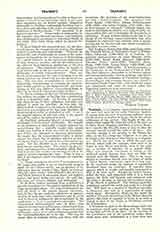

Transept, a rectangular space inserted between the apse and nave in the early Christian basilica. It sprang from the need of procuring sufficient space for the increased number of clergy and for the proper celebration of the service. The length of the rectangle either equals the entire breadth of the nave, as in Santa Maria Maggiore and Santa Croce at Rome, or it exceeds this breadth more or less, so that the transept extends beyond the walls of the nave. The transept, though, is not peculiar to the Roman basilica, as was for a long time believed; it is also to be found in the churches of Asia Minor, as at Sagalassos. Beside this first form, in which the apse was directly united with the transept, there were to be found in Asia Minor and Sicily, even in the early era, a number of churches of a second form. These were formerly considered to belong to the medieval period, because they were not fully developed until the Middle Ages. This is the cross-shaped or cruciform church, over the origin of which a violent literary controversy raged for a long time. In the cruciform design the transept is organically developed from the structure. It contains three squares which in height and breadth correspond to that of the main nave. Beyond the central square, called the bay, and connected with it is a fourth square, the choir, and beyond, and connected with the choir, is the apse; in this way the cruciform shape of the church is produced. The transept generally terminates towards the north and south in a straight line. Still there are a number of churches, especially in Germany, that end in a semicircular or triple conch shape. Strzygowski thinks he has found the model of this style of structure in the Roman imperial palace; this form of transept is found in as early a church as that of the Virgin at Bethlehem erected by Constantine.
A favorite method in the Romanesque style was to construct small apses opening into the transept to the right and left of the choir. In the churches of the Cistercians and of the mendicant orders these small apses were transformed at a later date into numerous chapels, as at Santa Croce at Florence. The prototype of this design can also be proved to have existed in the East and the districts under its influence. The doubling of the transept, however, seems to have been peculiar to Western architecture; this type of transept appeared both in the Romanesque and in the Gothic periods, although the manner of producing it varied greatly. Many Romanesque churches are constructed at the west end the same as at the east, that is, the west end also contains a transept and choir. The earliest known church with this double transept is the eighth-century church of St-Riquier at Centula in France. The style was also adopted in the Church of St. Pantaloon at Cologne (981), and almost at the same time by Mittelzell on the island of Reichenau in Lake Constance, and in many other churches. The west transept disappeared in Gothic architecture, excepting that in England some of the great cathedrals have a second, short transept added to the east choir, as at Salisbury. Gothic architecture also emphasized the choir by giving it in the large cathedrals three aisles; in this way very beautiful vistas are produced. In the effort to gain large, well-lighted spaces the architecture of the Renaissance and the Baroque periods enlarged the transept and covered the bay with a cupola which cased the transept to dominate the entire structure.
BEDA KLEINSCHMIDT

